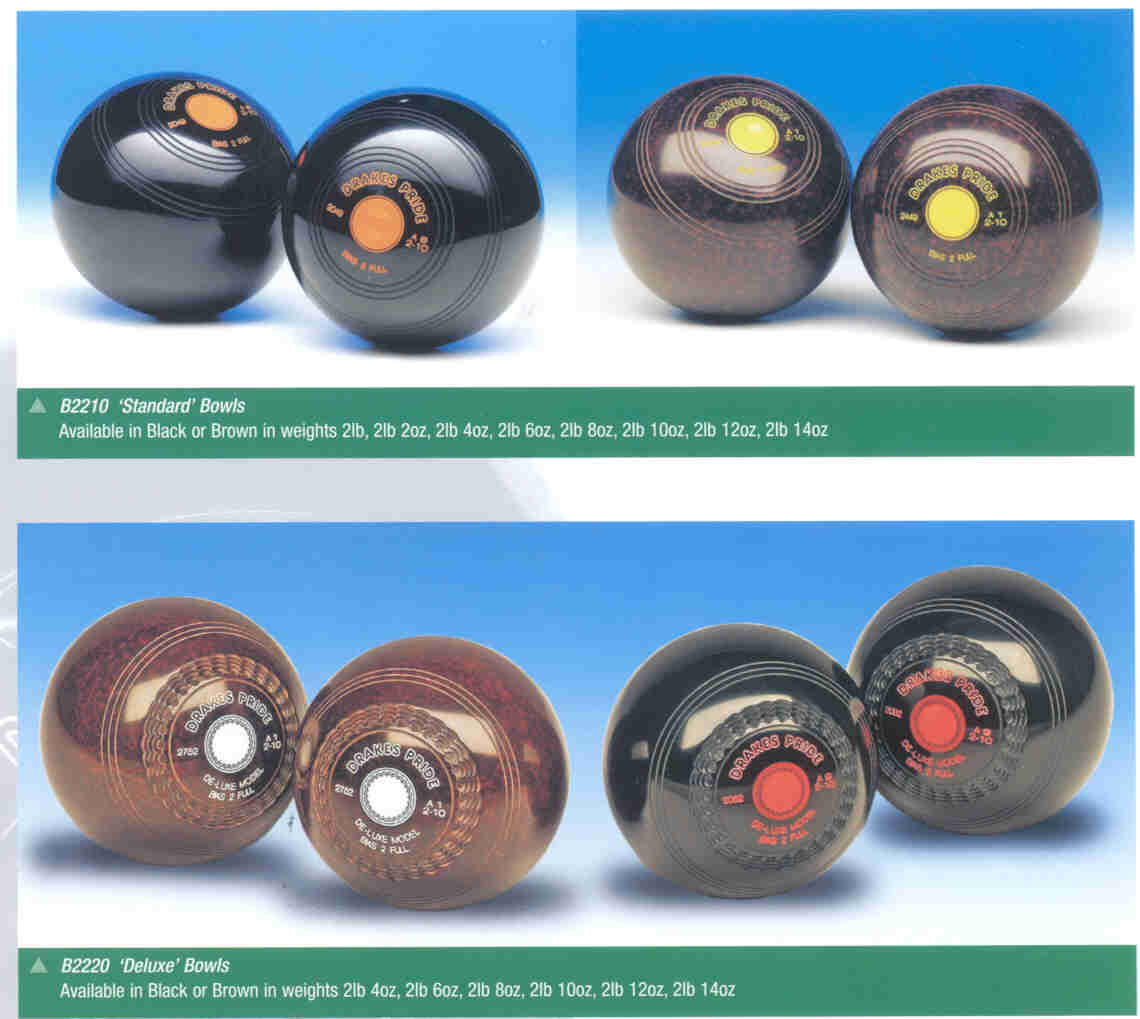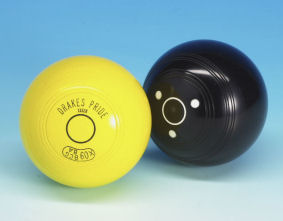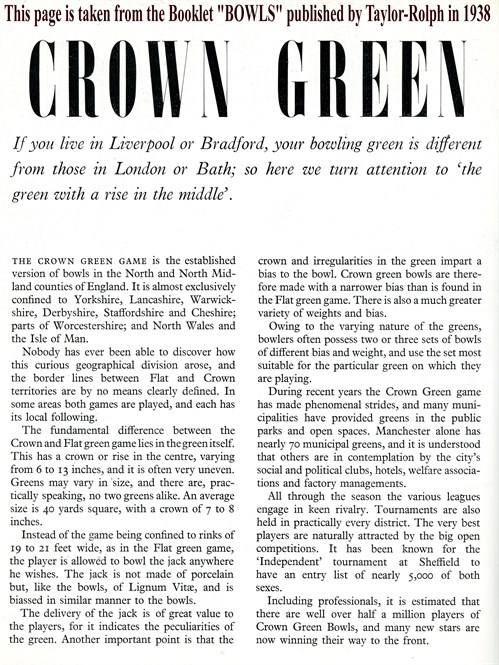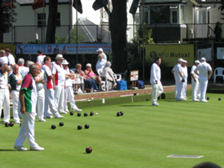Article 7 - Crown Green
ARTICLE 7 - Crown Green Bowls
(Originally published in 1998 and revised in 2019)

Images of some models of Drakes
Pride Crown Green Bowls
All of the articles I have written
have in general been more about or refer to lawn bowls and I have
only made passing reference to other, closely associated, bowls
disciplines. So I thought I should cover and look at those other
disciplines in the next few issues.
As I am based in Liverpool, I grew up aware of only Crown Green
Bowls. In fact, crown green bowlers used to speak in fairly
derogatory terms about lawn bowls, for example "all those silly
people dressed in white" or "like playing marbles up and down an
alley its dead easy". However, I am pleased to say that those
feelings and comments are becoming a thing of the past as more
crown green bowlers are aware of the different skills needed by the
associated disciplines. I am sure that the main contributor to this
change in attitude has been the televising of such events, as the
World Indoor Bowls.
Mind you, some attitudes are more difficult to change. For
example, about ten years ago (1988) a gentleman from Tulsa,
Oklahoma came to our works in Liverpool and he told us that he was
developing a bowling green in Tulsa and could we help with the
supply of bowls. Naturally I agreed we could and promptly offered
him lawn bowls (you will note I was already a convert!). He looked
at me slightly aghast saying that it was a crown green that he was
developing alongside one of the Tulsa City golf courses. He then
accused me, in jest, of wanting to sell sets of bowls with four in,
rather than the pairs of crown green required! My comment was that
I was promoting the International Game, which would allow him to
play not only against other bowlers in the U.S.A., but other
bowlers world-wide.
The reason that this first crown green was developed and built
in Tulsa, since then another one has been developed, was that he
had been stationed at Burtonwood, just outside Liverpool, and had
married a local girl from Warrington. Therefore the only game of
bowls that he was aware of, was in fact crown green. Several bowls
tours have been made to Tulsa and the visiting players have always
enjoyed great hospitality.(Sadly I hear that since the gentleman
who introduced the game to Tulsa moved to Arizona the greens are no
longer in use. It seems that as the greens were so isolated from
Crown Green territory that once the 'force' behind the idea left
the game faded in Tulsa. In about 2000 a lawn green at a Club in
Sydney was made into a crown green one and they had the idea to try
and promote the crown green idea in Australia but this idea did not
last long.)
T.V. helped with the recognition in crown green areas of lawn
bowls for example Granada T.V., who ran a very successful
"Superbowl" series. Its format which brought not only indoor bowls
to the North West, but also put crown green players against lawn
bowlers and ladies bowlers against the male bowlers, was a success.
Sadly it seems it was ahead of its time and the other independent
channels didn't take it up.
The crown players won a lot of respect, for example Rob Crawshaw
beat David Bryant with Noel Burrows, another crown green bowler,
actually winning the event one year. Although the most memorable
final was the last one played, Margaret Johnston MBE was beaten by
David Corkhill with the last bowl delivered. Since then, the fact
that the World Indoor has become a very popular televised event in
Preston with a knowledgeable local audience has helped the crown
green players respect the skills of the lawn bowler.(The main TV
bowls event has for a number of years been the World Indoor which
currently, as at 2009, is hosted and sponsored by Potters Holiday
Resort, Suffolk)
When I am asked which is the more difficult game, I try and
explain that though the object of both disciplines are the same,
the games require different skill combinations. In crown green, for
example, the skill in reading the green and being able to adjust to
it. Or, finding a particular length or area of green where your
particular bowls or your own skills in reading the green means you
out perform your opponent, is all part of the art of the crown
green game.
In Lawn Bowls tactical skills, the careful placing of the bowls
at the head, is perhaps the major skill also the fact that the
games take longer thus making concentration a very significant part
of the game with the green craft skill being a secondary part of
the game.
Perhaps even more than in lawn bowls the bias of the bowl plays
a major part in the crown green game. As you follow a biased jack
it is essential to have a pair of bowls which will follow exactly
that line, an a fraction different in bias (particularly if less
bias) can be magnified greatly by the contours of the green. The
only controversy over "tight line" bowls in crown green bowls is
that no one wants them !!.

Drakes Pride Crown Green Standard
Jacks
Some things in crown green are perhaps more logical, or is it
that I am more used to them (?), for example crown green players
when delivering their bowls refer to thumb or finger bias. To
translate, if one holds the bowl (right hand description) with the
bias side to your little finger, it is said to be finger bias. With
the bias side to your thumb it is thumb bias. I think that in
rather more easily understood than fore and back hand, but perhaps
because of my early days I'm "biased"!
Crown green bowls differ not only in the sizes but the way the
bowler describes them. For example a crown green pair of bowls
would be described as being a 2 lbs. 10oz. pair or a 2 lbs. 12oz
pair, rather than by a size. A 2 lbs. 12oz pair of bowls being the
average for male bowlers and is equivalent to a size 2 Medium in
flat green. The average crown green bowl tends, as you will note,
to be smaller than the flat green bowl due to the different grip
and delivery. A crown green bowler also has to achieve the long
lengths especially when bowling corner to corner.
The other significant difference is that the crown green bowls
still have the white discs, both of which are the same size and so
to show which is the bias side it is usual to have a dimple in that
disc. Some bowls players feel they can get an advantage by trying
to confuse their opponents by not having the dimple so that they do
have a guide. They put a very small or black dot on the bias disc
or others do not like the feel of the dimple and will have a black
dot on the bias side. The disc was originally a way for the bowls
turner to hide the heart crack that is always present in Lignum
Vitae bowls and for some reason this 'tradition' has continued even
when the bowls are made from composition. Some Crown Green bowlers
still prefer their Lingmum 'woods' especially on heavy greens as
they can 'reach' the distances better - there is a saying that a
'Lignum bowl rolls on a yard after it has stopped'!! Lignum bowls
certainly have a look and feel that is better than composition
bowls but do need more care and attention.

Terms that will not be know by Lawn Bowlers players which are
used by crown green bowlers are such descriptions an "round peg"
and "straight peg. "Straight peg" is when you are playing along one
of the sides of the crown green, close to the ditch, and playing
with the bias of the bowl played to take the bowl away from the
ditch. However, because of the fall-off of the playing surface
towards that ditch, the bowl is trying to climb up the slope and as
a result of the surface pulling one way and the bias the other. The
bowl tends to appear to be running straight. In fact, sometimes it
may even run off against its bias because of the lie of the playing
surface. This is known as a falling mark.
Round peg on the other hand is playing the other way in a
similar position. In other words you are playing with the bias side
towards the ditch, and, therefore the bowl tends to show greater
bias because it is coming down the slop of the green. It should be
noted that with both of these effects that the running sole shape
of the bowl is very important. A broad running sole will on a
falling mark tend to hold its line more than a narrow running sole
bowl, in other words the green will affect the narrow running sole
bowl on a falling mark to a greater extent. With the "round peg"
this effect is all but reversed and so you will realise that the
"green craft" of the top crown green players is their great
strength.
On a crown green the test of a pair of bowls of good shape
performing as a matched pair is on a straight/falling mark! So much
so that one of our employees who shall remain nameless, feels all
bowls should be tested on an angled test!! Any weak or under biased
bowls would not hold against the slope of the test or therefore the
green!
Perhaps one of the things that most people would have thought
was an obvious difference between the disciplines was the fact that
the crown green jack is a miniature bowl complete with its own
bias. This certainly is the item which stands out, also the fact
that that jack can be randomly delivered any where on the green
adds to the confusion when observed by a dedicated lawn bowl and
particularly true when overseas players view the game.
For example, this year (1998) Drakes Pride had a visit from 32
bowlers from Surfers Paradise Bowls Club in Queensland. All
commented on their afternoon of crown green bowls played at the
Calderfield Bowling Club in Woolton, Liverpool, that they had found
the reading of the green the most difficult part. Especially as
they imagined it would be a "perfect" crown, not one with little
dips and rises on it. They certainly felt that the home team would
have a great advantage in crown green bowls more than would be the
case at lawn bowls.
Certainly the world game is lawn bowls, but there is a
significant and dedicated area of crown green bowls which lies
roughly in an area East Coast to West Coast with Birmingham in the
South and the Lake District in the North and includes North Wales
and Isle of Man.
The mecca for crown green bowls is the green at the Waterloo
Hotel in Blackpool. Many of you will have seen the televised
tournaments from there and perhaps got a feel for the tremendous
atmosphere, with the bookies in full cry and the crowd expressing
their comments to each other and the bowlers as soon as the bowl
leaves the hand.
It is the crown green bowlers who we have to thank for
developing our skills at Drakes Pride. Their ongoing requests for
different shapes for handling and performance, varying bias's for
different greens are all part and parcel of our everyday work in
our renovation department. This has given the company a great feel
for what makes a "good" bowl and lets a bowler enjoy their
game,which ever discipline they play.
In 2019 Jean & Maurice Rogers of Pershore Bowls kindly
donated items to the Collection. Amongst then was a booklet
published in 1938 by Taylor-Rolphin which was a page dedicated to
Crown Green Bowls which we though worth producing below :-

Frequently Asked Questions about Crown Green
Bowls.
Question. Are wooden bowls still
used?
Answer. Wooden bowls, which are made from
the timber Lignum Vitae, are still used and are very popular.
It is now difficult to obtain good quality Lignum to make new bowls
but Thurston do still have a small stock of timber from which to
make their Standfast Crown Green bowls (see B2200).
Thurston's renovate many pairs of wooden bowls mainly during the
closed season ( see section 1 for renovation services) and are
recognised by many as the leaders in the field.
Question. Can I have my wooden bowls
polished natural.
Answer. Yes, any wooden bowls can be
polished natural. It should however be remembered that all
Lignum Vitae (wooden) bowls have cracks and the clear, specially
formulated lacquer applied shows up all the imperfections so if the
Lignum is poor or contains sapwood it is sometimes more sensible to
have the bowls polished Black.
Question. What size of bowls are
available and which is most suited for my use?
Answer. Crown green bowls have always been
sold by weight as the size designation. The popular weights
being 2lb 6oz, 2lb 8oz, 2lb 10oz and 2lb 12oz. It seems that
with the Lignum Vitae, (wooden) bowls the bowlers were more
interested in the weight and it is was certainly true that in
earlier years the heavier the bowl that one could handle was always
considered to the best bowl for the job. Modern Crown Green
bowls are made from a composite material which is so hard diamond
tools have to used to turn the material. Thurston's stock a
range of bowls from 2lb 4oz to 2lb 12oz in even weight steps, odd
weights such as 2lb 9oz, 2lb 11oz, etc can be supplied to
order. Also for children we have in stock 2lb and 2lb 2oz
bowls.
Question. I have heard of Hi-density
bowls, what are they ?
Answer. Material now used for bowls is a
phenolic thermoset composition. This can be produced to a
specific density, unlike Lignum Vitae (wooden) bowls where the
density depends on the actual original timber. Manufacturers
using the composition material such as Drakes Pride and Taylor have
extended their standard composition weight range of crown green
bowls to include both hi-density and also low density models.
Question. Can you explain what advantages
high density or standard or low density have compared to each other
?
Answer. This requires quite a long answer
and must include a reference again to Lignum Vitae (wooden) bowls
as well. It is said that a Lignum (wooden) bowl runs on a
"yard" after it is stopped. What is being implied is that
when comparing the run of a wooden bowl against the original, now
called standard weight composition, it is true that for a given
strength of delivery the composition bowl will stop about a yard
shorter than the Lignum (wooden) bowl. The reason is simply
that the standard weight composition bowl is slightly heavier for
its size than the average wooden bowl.
What the manufacturers have done is to take a slightly higher
specific gravity composition material and produce a bowl which is
heavier for its size than a standard composition. For example
a high density 2lb 8oz bowl is about the same size as a 2lb 6oz
standard weight. High density bowls are useful on very fast greens
which usually occur after a period of dry weather or especially
after dry and hot days. The other advantage is that if a
bowler suffers from a hand problem and they are having difficulty
gripping the larger bowl, but still want to maintain the weight,
then the hi-density allows them to come down a size but maintain
the weight.
On the other hand a low-density composition bowl, made from
slightly lighter material than the standard weight and is more
similar to Lignum (wooden) bowls in its density is better suited to
heavier greens, such as early season or rain effected or "heavy"
greens. The reason being that as they are lighter they "ride"
the surface more easily and therefore run further. A 2lb 8oz
low-density bowl will be approximately the same size as a 2lb
10oz standard composition bowl. It is also useful for
low-density bowls to be polished as this helps to feel more like a
wooden bowl. Thurston's stock the Excel
model by Drakes Pride (see B2222) which is a low density, polished
bowl. Also, made to order "Harlequin" coloured bowls
available in 5 colours(see B2275). Speckled coloured crown green
are stocked see item B2210/SP.
At the Liverpool Thurston stores there are
examples of the different weights and densities of crown green
bowls so you can try them in the hand for size and feel.
Question. What size bowl do I need
?
Answer. Bearing in mind the answer to the
previous question. The simple answer is what feels
comfortable in your hand. Remember that you have to be able
to hold the bowl even in wet conditions. IF the bowl feels
right, then it is probably the right size and if it doesn't feel
"right" then this will be in your mind when you are playing your
shots.
Question. Do I need a jack?
Answer. If you are wanting to practice or
just play socially, then the answer is definitely yes. But if
you only play at the club with other club members then it is usual
for the club to supply the jacks as they do for matches and then
you would not need one. The crown green standard jacks are
available from Thurston's
in both the traditional Black and the popular Yellow versions (see
B2000 & B2030) or use a practice jack, 2 full bias see item
B2060 .
Question. What bias should I use ?
Answer. Some years ago you used to be able
to tell what area a bowler came from by the bias they requested,
but in more recent years the standard bias of 2 full has proved to
be dominant. This is the same bias as the standard jacks
which most clubs have. Other biases that are available to
special order are 2 ¼ bias which is slightly stronger than the 2
full and also 2 ½ bias which is stronger than the 2 ¼.
Question. My friends bowls have no
dimple, are they legal?
Answer. Most crown green bowlers prefer to
have the dimple in the bias side but some keen bowlers who do not
want their opponent to see how they have delivered the bowl
sometime opt to have no dimple and occasionally mark the bias side
with just a black spot.
Question. My recently polished bowls are
showing pin prick marks is the polish faulty?
Answer. Probably not, the usual reason for such
marks, which tend to be seen at the start of the season, is the
fertiliser and top dressing applied to the greens. Granular
fertiliser and top dressing can break through the polish causing
blemishes. In most cases top dressing contains 70% sand and this
creates an abrasive surface early in the season. Chemical
fertilisers can break down the adhesion of the polish on the bowls
so it might start to come away.
Question.
Our Clubs Standard Jacks have
been three stamps on. Can they be
re-tested?
Answer. The
B.C.G.B.A. States ' Jacks (Standard) are not to be stamped on more
than four occasions. The first three, in date order to be made on
the bias side. So a Standard jack with three date stamps can be
re-tested and providing meets the regulations can be re-stamped for
the four & final time
with the stamp on the non bias side.
In 2018 the B.C.G.B.A require
that the date stamps on the Standard Jack must run
consecutively.
© Peter Clare 2009 - © E.A. Clare & Son Ltd. 2018.
This article can only be reproduced in part or whole with the
permission of E. A. Clare & Son Ltd.

